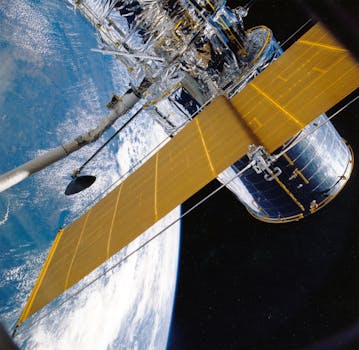GEO Satellites: Understanding the Technology and Applications of Geostationary Orbit Satellites
GEO satellites, or geostationary orbit satellites, are a type of satellite that orbits the Earth at an altitude of approximately 36,000 kilometers above the equator. At this height, the satellite’s orbital period matches the Earth’s rotational period, allowing it to remain stationary relative to a fixed point on the Earth’s surface. This unique characteristic makes GEO satellites an essential part of modern telecommunications, as they can provide continuous coverage of a specific region or country.
The technology behind GEO satellites is based on the principles of orbital mechanics and satellite communications. A GEO satellite is launched into space using a powerful rocket and then positioned in a geostationary orbit using a combination of propulsion systems and gravitational forces. Once in orbit, the satellite deploys its solar panels and antennas, which are used to transmit and receive signals to and from Earth. The satellite’s payload, which includes transponders, amplifiers, and antennas, is designed to receive signals from Earth, amplify them, and then re-transmit them back to Earth, allowing for communication between two or more points on the planet.
Applications of GEO Satellites
GEO satellites have a wide range of applications, including telecommunications, weather forecasting, navigation, and entertainment. In the telecommunications sector, GEO satellites are used to provide internet connectivity, telephone services, and television broadcasting to remote or underserved areas. They are also used to provide backup connectivity in case of fiber optic cable outages or other network failures. In weather forecasting, GEO satellites are used to monitor cloud patterns, storm systems, and other meteorological phenomena, allowing for more accurate weather predictions and warnings. Navigation systems, such as GPS, rely on GEO satellites to provide location information and timing signals to receivers on the ground.
In addition to these applications, GEO satellites are also used in the entertainment industry to provide television programming and other services to subscribers. They are also used in the military and government sectors to provide secure communications and surveillance capabilities. With the increasing demand for satellite-based services, the GEO satellite market is expected to continue growing in the coming years, with new technologies and innovations emerging to support this growth.
Challenges and Limitations of GEO Satellites
Despite the many advantages of GEO satellites, there are also challenges and limitations associated with their use. One of the main challenges is the high cost of launching and operating a GEO satellite, which can be hundreds of millions of dollars. Additionally, the orbital slot allocation process can be complex and contentious, with many countries and organizations competing for limited slots. The risk of satellite failure or collision with other objects in orbit is also a concern, as it can result in significant financial losses and disruptions to services.
Another limitation of GEO satellites is their relatively low bandwidth capacity compared to other types of satellites, such as medium Earth orbit (MEO) or low Earth orbit (LEO) satellites. This can limit their ability to support high-speed data applications, such as video streaming or online gaming. However, new technologies, such as high-throughput satellites (HTS) and very high-throughput satellites (VHTS), are being developed to address this limitation and provide faster and more reliable connectivity.
Future of GEO Satellites
The future of GEO satellites looks promising, with new technologies and innovations emerging to support their continued growth and development. One of the main trends in the GEO satellite market is the increasing use of HTS and VHTS, which are designed to provide faster and more reliable connectivity. These satellites use advanced technologies, such as spot beams and frequency reuse, to increase their bandwidth capacity and support high-speed data applications.
Another trend in the GEO satellite market is the growing demand for satellite-based services in emerging markets, such as Africa and Asia. As these regions continue to develop and grow, the demand for satellite-based services, such as telecommunications and weather forecasting, is expected to increase, driving growth in the GEO satellite market. With the increasing use of satellite-based services and the development of new technologies, the GEO satellite market is expected to continue growing in the coming years, providing essential services and connectivity to people around the world.





